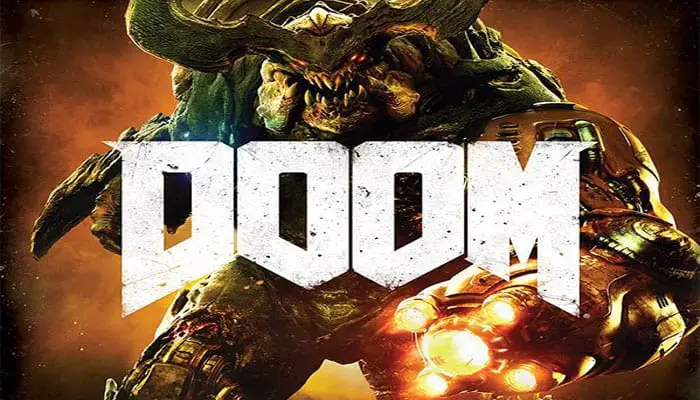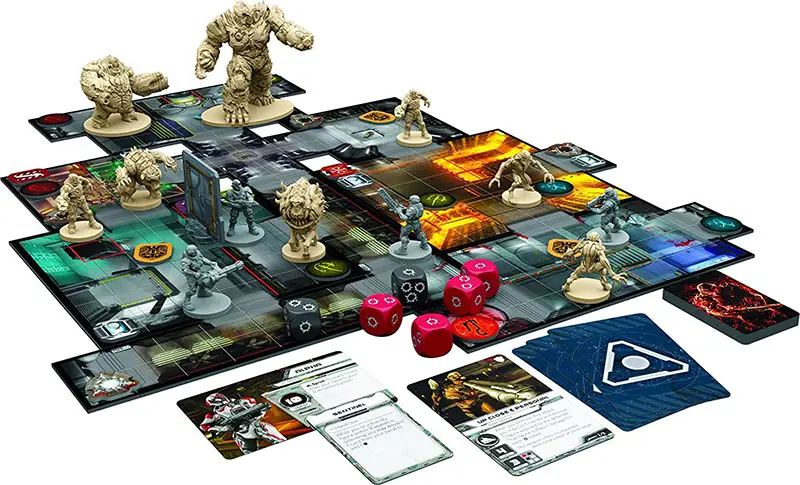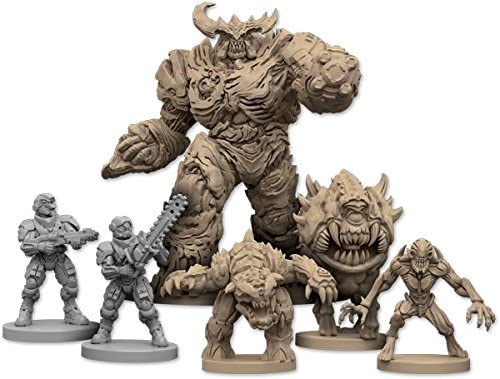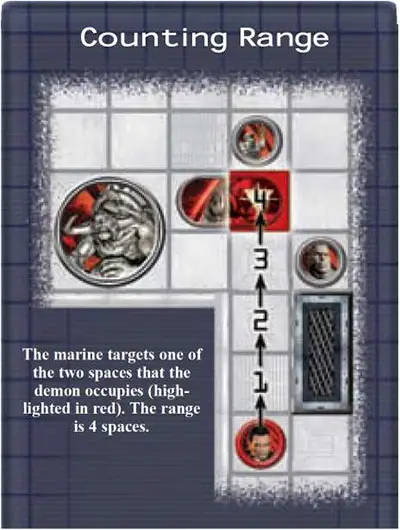
In Doom: The Board Game, demonic invaders have broken through from another dimension into the Union Aerospace Corporation's Mars base. Marines have been deployed to the base to protect UAC personnel and destroy the invaders.
Up to three players will take the roles of heavily armed and highly trained marines, while one player will control the legion of demonic invaders.
In the game, the marine players explore the claustrophobic rooms and corridors of the Mars base, attacking monsters, picking up new weapons and equipment, and working together to complete specific mission objectives.
In many scenarios, the invader player's goal is to frag (kill) the marines a certain number of times. Failing that, the invader player will seek to prevent the marines from completing their objectives.
In addition to simply controlling the monsters on the board, the invader player can create nasty surprises by playing event and spawn cards against the desperate marines.
Components

- 66 Plastic Miniatures
- 6 Custom Dice
- 84 Cards
- 1 Compass Rose Token
- 3 Marine Equipment Bins
- 58 Map Pieces
- 14 Door Tokens
- 14 Plastic Door Stands
- 31 Prop Tokens
- 30 Wound Tokens
- 15 Armor Tokens
- 10 Marine Order Tokens
- 113 Equipment Tokens
- 1 Scenario Guide
- 4 Reference Sheets
Object of the Game
In KNEE DEEP IN THE DEAD, the marine players struggle to escape a demon-infested section of the Mars base. To do so, they must find the red key token and fight their way to the red security door.
The invader player tries to score a total of 6 marine kills or "frags" before the marines can escape the board.

Setup
Follow the steps below to prepare for the KNEE DEEP IN THE DEAD scenario. Other scenarios may have special setup rules of their own.
-
Choose an Invader and Marines
Select one player to play the invaders. It is recommended that the most experienced player take the invaders, but you may choose at random if you prefer.
The other players are the marines, and each of them should choose one of the three marine colors-red, green, or blue-to represent themselves.
-
Choose a Scenario
The invader player looks through the Scenario Guide and selects a scenario to play.
For the purposes of these rules, we assume that you'll be playing the KNEE DEEP IN THE DEAD scenario.
-
Create the Game Board
The invader player now creates the part of the game board that forms the starting area of the scenario (specially marked under each scenario).
Important: Place the compass rose token near the board pointing in the direction indicated in the Scenario Guide. The compass rose is used when applying the scatter diagrams found on the invader cards.
-
Put Starting Pieces on the Board
The rules for each scenario in the Scenario Guide explain how to set up the board at the beginning of a new game.
Place the marine and invader figures in the starting area as shown, as well as any equipment tokens located here (see diagram below).

-
Setup Marine Equipment
Each marine player now receives the marine equipment bin in his color. Marine players also receive ammo tokens, wound tokens, and armor tokens based on the number of marine players (see below). Place these tokens on the equipment bin in the indicated areas.
Marines Shells/Bullets Wounds Armor 1 4 10 2 2 3 9 2 3 2 8 2 Example: In a three player game, one player will take the role of the invaders, and the two other players will take the role of the marines.
Since there are two marine players, each marine places 3 shells/bullets, 9 wounds, and 2 armor in his equipment bin.
-
Deal out Starting Cards
Separate the marine cards and the invader cards, then shuffle each deck individually.
Each marine player draws the number of marine cards indicated below. Each player should place these cards face up in his play area.
Marines Cards 1 3 2 3 3 2 The invader player then draws 5 invader cards (regardless of the number of marines). The invader player should look at his cards but not reveal them to the marine players.
-
First Marine Player
The marine player sitting to the left of the invader player is the first marine player.

Game Play
Doom: THE BOARD GAME is played over a series of rounds. During each round, every player receives one turn, starting with the first marine player and continuing clockwise.
After the invader player has taken his turn, the round is over and the next round begins with the first marine player taking his turn once again.
One round consists of:
- Turn 1: First Marine Player's Turn
- Turn 2: Second Marine Player's Turn
- Turn 3: Third Marine Player's Turn
- Turn 4: InvaderPlayer's Turn
If playing with less than three marine players, simply skip the turn of the missing marines.
The Marine Turn
As the first event of his turn, a marine player must choose an action from the four listed below. Amarine is not allowed to do anything before he has declared which of the four actions he is executing.
After the marine has resolved his entire action, his turn is over and play passes to the player on his left.
The four possible actions are:
-
Sprint
A marine that sprints may move up to 8 spaces during his turn, but cannot attack.
-
Unload
A marine that unloads may make up to 2 attacks during the turn, but cannot move. Each attack is completely resolved before the marine makes the next attack.
Important: A marine may use a different weapon each time he attacks, even when unloading.
-
Advance
A marine that advances may move up to 4 spaces and may make1 attack during the turn. An advancing marine may make his attack before, after, or at any point during his movement.
Example: An advancing marine could move 1 space around a corner, attack an invader, and then move 3 additional spaces in any direction (including back around the corner).
-
Ready
A marine that readies can either move up to 4 spaces or make 1 attack during the turn. In addition, a marine that readies may place 1 marine order next to his marine on the board.
The order may be placed at any time during his turn. These orders grant the marines special actions/abilities later in the round, often during the invader player's turn.
Invader Player's Turn
After all marines have taken their turn, it is time for the invader player to act. The invader player's turn is divided into 3 steps. After the invader player has resolved all 3 steps, his turn is over and the round ends.
- Step 1: Draw and Discard
- Step 2: Spawn
- Step 3: Activate Invaders
Step 1: Draw and Discard
To begin the invader's turn, the invader player must draw 1 card from the top of the invader deck foreach marine player.
If this leaves the invader player with more than 8 cards in his hand, he must immediately select and discard enough cards so that his hand size is reduced to 8.
When the invader player draws the last card in the invader deck, he scores 1 frag point. He then creates a new invader deck by shuffling the discard pile into a new deck.
As described before, the cards in the invader deck are either event cards or spawn cards.
Playing Invader Event Cards
The invader player may play his event cards at any time as long as the conditions on the card have been met. After playing an event card, simply follow the printed instructions, resolve the effects, and discard the card in a discard pile.

Example: After a marine player has picked up a shotgun equipment token, the invader player decides to play the "It's a Trap!" event card.
This card allows him to immediately activate up to 2 invaders before the marine's turn can continue. After he has activated both invaders, the card is discarded and the marine player continues his turn.
Step 2: Spawn
After drawing his cards for the turn, the invader player may play 1 (and only 1) spawn card from his hand.
After playing a spawn card, the invader player takes the invaders shown on the card and places them on the board.
The following rules limit how the invader player may place spawned invaders on the board:
-
The invader player must place any spawned invaders on spaces that have no line of sight to any marine figures on the board.
If the invader player cannot find a legal space on the board for one or more of the invaders, he cannot place those invaders. After any spawned invaders are placed on the board, the used spawn card is placed in the discard pile.
Exception: For purposes of spawning new invaders, other invader figures do not block a marine's line of sight.
Important: Many spawn cards are divided in half by a gray line. When playing such a card, the invader player must choose between the two different groups of invaders.

Example: This card may be played to spawn either one demon or both an imp and a zombie.
-
The invader player cannot place more invaders on the board than there are available figures. For instance, if all six hell knight figures are already on the board, the invader player cannot spawn an additional hell knight.
If the invader players wishes to spawn a figure on the board, but he is already using all of his available figures, he may choose to remove an invader figure from the board, to make that figure available for immediate placement by a spawn card (or when a new area of the scenario is revealed).
Remember that all invader figures of the same color as an unused marine are placed in the box before the game starts. These figures are not available to the invader player.
Thus, in a three-player game where only the red and the green marine figures are being used, the blue invader figures are not available to the invader player.
Step 3: Activating Invaders
After playing a spawn card (or not), the invader player may activate each invader on the board once. To activate an invader, the invader player simply declares which invader is being activated and consults his reference sheet.
When an invader is activated, it may move a number of spaces up to its movement score and make one attack. Just like an advancing marine, an invader may take its attack before, after, or at any point during its movement (see later).
After the invader player has had the chance to activate every invader figure on the board, his turn is over. The round is then complete, and a new round begins with the first marine player.
Movement
Movement works much the same for both marines and invaders, with one key difference:
A marine's movement is based on the action he has taken for the turn (for example, an advancing marine has a movement of 4).
An invader figure's movement is based on its movement rate recorded on the reference sheet (for example, a trite has a movement rate of 5).
The controlling player moves his figure, one space at a time, across the board until he has either used all of the figure's allowed movement, or is satisfied with its position. The controlling player may choose not to use all of the figure's movement if he so chooses. Several examples of movement are shown in the diagram below.
The following rules apply to movement:
Figures may move into any adjacent space (including diagonal spaces), but must remain completely on the board at all times during the move.
Figures may pass through spaces occupied by friendly figures during movement, but must end their turn in an empty space.
Figures can safely move next to and/or around enemy figures unless the enemy figure has the watch ability (see the last page of this rules booklet for a summary of special abilities, including watch).
Figures cannot move into or through closed doors, blocking obstacles, or enemy figures during their movement.
Attacks may be made at any point during movement. For example, a figure with a movement rate of 4 may move 2 spaces, attack, and then move another 2 spaces.
Special movement rules apply to the oversized invader figures (i.e., the demon, mancubus, hell knight, and cyberdemon).

Attacking
Every attack (for marines and invaders both) follows these steps:
- Step 1: Declare Attack
- Step 2: Confirm Line of Sight
- Step 3: Count Range and Roll Attack
- Step 4: Determine Attack Success
- Step 5: Inflict Wounds
Step 1: Declare Attack
The attacking player declares which space his figure is attacking. If the attacking figure is a marine, the player must also state which weapon the marine is using.
The following rules apply to attacks:
-
Melee attacks can only be declared against adjacent spaces. Weapons and invaders that are marked with a bottom red bar on the reference sheets can only make melee attacks.
-
Marines are always considered to have access to the fist, pistol, and grenade weapons (although the pistol and grenade weapons still require ammo tokens for use).
These weapons are outlined in green on the reference sheets. A marine cannot use any other weapon unless he has acquired the corresponding weapon token.
-
If a marine does not have at least one ammo token of a specific kind, he may not declare an attack with any weapon using that ammo type (see Ammo, later on).
Note that the attacking player nominates a space to attack, and not necessarily another figure. This is important for weapons that have a blast radius (see later).
When firing weapons that do not have a blast radius, the single figure occupying the nominated space is also considered the target of the attack.
Step 2: Confirm Line of Sight
In order to attack a space, the attacker must have line of sight to it. In other words, the attacking figure must be able to trace an uninterrupted straight line from the center of its space to the center of the space it is targeting.
If attacking with an oversized invader, you need only trace a line of sight from the center of one of the spaces it occupies to the center of the space it is targeting.
Line of sight is blocked by walls, closed doors, other figures, and blocking obstacles. Thus you cannot, for instance, shoot directly through one invader to hit another invader behind it.

Example: In the diagram above, the marine has a line of sight to the demon invader shaded in green, but not those shaded red.
The obstacle is blocking the line of sight to the zombie, the corner is concealing the cyberdemon, and the demon itself is blocking the line of sight to the archvile behind it.
Step 3: Count Range & Roll Attack
Next, the attacking player counts the number of spaces from the space occupied by the attacking figure to the targeted space. This is the range of the attack.

Example: As illustrated in the diagram above, the marine finds that the shortest path he can trace to his target is 4 spaces. Thus the range for his attack is 4 spaces.
After determining the range of the attack, the attacking player rolls the dice corresponding to the attacking weapon or invader. The specific dice used are listed on the reference sheet.
Example 1: When attacking with the pistol, the marine player rolls one yellow and one green dice.
Example 2: When the mancubus is attacking, it rolls one yellow, one blue, and one green die.
Step 4: Determine Attack Success

First, the attacking player checks to see if he rolled a miss result. If he did, the attack automatically fails. If no miss results are showing, the attacker adds up all the range number results on the rolled dice.
The attack hits if the total range of the rolled dice is equal to or greater than the range needed for the attack.
If the total rolled range is lower than the required range needed to hit the target, the attack fails and no damage is done.
Step 5: Inflict Wounds
If the attack hits, the attacking player counts the total number of damage (bullet holes) showing on the rolled dice. This is the total damage dealt to the figure in the target space. In order for this damage to have any effect, however, it must first penetrate the figure's armor.
A marine's armor rating is equal to the number of armor tokens on his equipment bin. An invader's armor rating can be found on the reference sheet.
In order to inflict damage to a figure (invader or marine both), the total damage must be equal to or greater than its armor rating. Thus, if a figure has 2 armor, it will take 2 points of damage to give it 1 wound.
It is possible for a single attack to deal more than one wound to its target. An attack deals 1 wound for every increment of damage equal to the target's armor rating.
For example, a figure with 2 armor would take 2 wounds if subjected to 4 damage from a single attack. Note that any "leftover" damage is wasted. For example, 7 damage given to a figure with an armor rating of 2 would still only cause 3 wounds.
This also applies in the case where a single damage point is dealt to a figure with an armor rating of 2+; the single damage point is wasted and the attack has no effect.
Example: The attacking marine now counts the total damage on the dice he rolled for the attack (2 on the yellow die and 1 on the green die) and announces that he has dealt 3 damage to the demon.
The demon has 3 armor, so the attack penetrates the demon's armor and causes 1 wound. The invader player places one wound token next to the demon.
When a marine suffers a wound, he must remove one wound token from his equipment bin (simply move the token off the bin and place it nearby). When a marine removes the last wound token from his equipment bin, he has been fragged.
Conversely, when an invader suffers a wound, the invader play- er places a wound token (from the pile near the board) next to the actual figure on the board.
An invader figure is killed when the number of wound tokens it has received equals to or exceeds its wound rating (as indicated on the reference sheet). Akilled invader figure is simply removed from the board and becomes available for spawning once more.
Special Abilities
Many weapons and creatures have special abilities when attack- ing (and some while moving). Be sure to familiarize yourself with these special abilities by studying the reference sheet.
Each special ability is represented by an icon that is described in detail on the last page of this rules booklet.
Continue Reading
